After four days, 19 lecture streams, hundreds of speakers and 5000 delegates passing through the doors of Birmingham’s International Convention Centre, IBMS Congress 2023 came to a close. Here we look back at a selection of the sessions and activities at this year’s event, which had the theme “Linking learning to the laboratory”.

Congress opening address
IBMS President Debra Padgett praised the profession in the Albert Norman Keynote Opening Address.
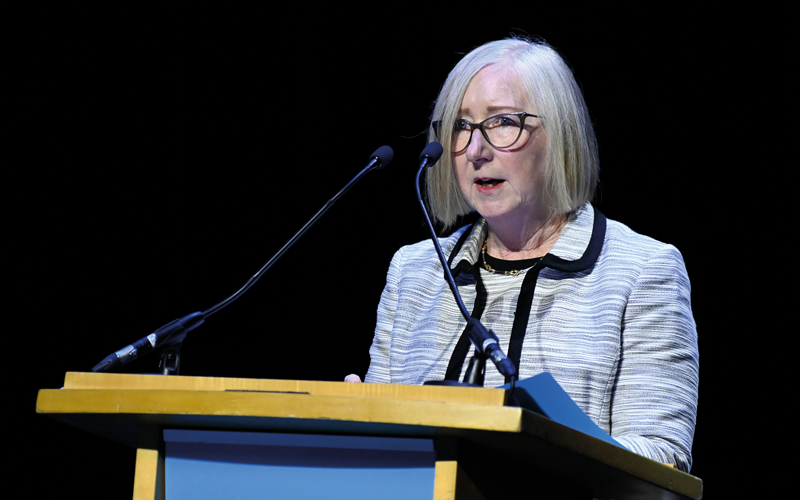
She said: “I’d like to thank you for your resilience in the pandemic recovery response. This period of social history gives us the opportunity to show that we can rise to the challenge.”
Debra added that it is vital that the profession does not lose momentum as the pandemic wanes.
She discussed the IBMS’ work over the last year, including the active role the Institute is now playing in politics and lobbying, leading to major government bodies and NHS England (NHSE) seeking the IBMS’ views and expertise.
Inclusivity was one of the central themes of her address, ranging from the IBMS widening access to accreditation through moving to virtual assessments and equity, diversity and inclusion being “intrinsic to everything that we do”.
Debra was introduced by the Chair of the Opening Plenary President-Elect Joanna Andrew and noted that it was the first time in the IBMS’ history that both President-Elect and President are women.
“I am proud of what we have achieved and I’m proof that you can achieve your goals and dreams,” said Debra. “Anything is possible if you want it enough.”
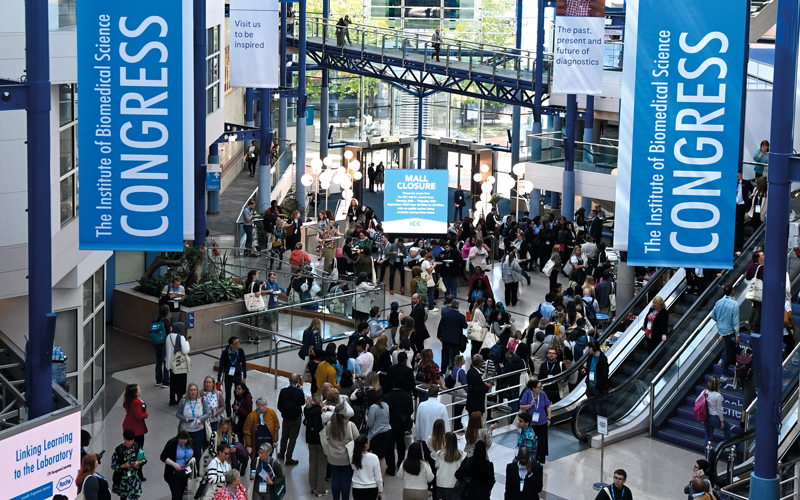
The future of diagnostics
Expanding opt-out HIV testing is a “no-brainer”, according to MP Maggie Throup, who is Chair of the All-Party Parliamentary Group for Diagnostics.
The MP, who was a biomedical scientist before entering politics, made the statement in a Congress speech on “the value of diagnostics”.
Opt-out testing has already been launched in London, Blackpool, Brighton and Manchester.
The approach aims to destigmatise and normalise HIV testing and to address inequalities in access to HIV care.
“I hope opt-out testing is expanded – it’s a no-brainer for decision-makers in government and the NHS,” said Throup.
The MP was discussing ways in which biomedical science could ease pressure in healthcare and called those who work in diagnostics “the unsung heroes of the NHS workforce”.
One way she suggested pressure could be eased was embracing point-of-care testing in GP surgeries and pharmacies.
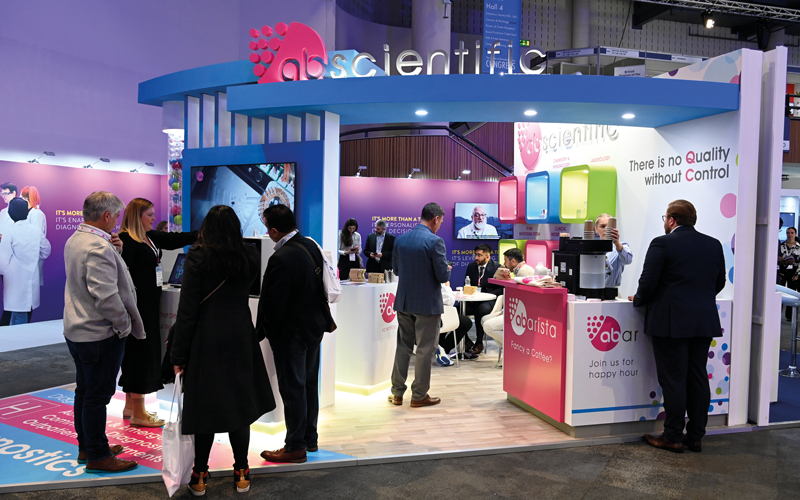
She stressed that biomedical scientists need to be involved in the process. “You have a role to play in training and quality assurance,” she said.
Throup also said that community diagnostic centres could have a positive impact in the future.
However, she recognised that there are many challenges facing the biomedical science profession, including the workforce shortage, ageing equipment and a lack of connectivity between IT systems.
She concluded: “The pandemic helped to raise the profile of diagnostics. Now is the time to capitalise on that awareness and secure the future workforce.”
IBMS workforce plan launched
The IBMS Long Term Biomedical Scientist Workforce Plan was launched at Congress.
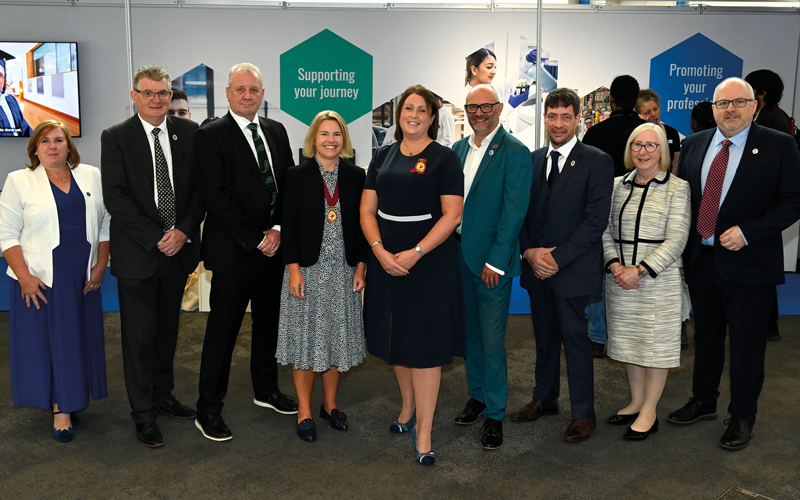
It presents a bold strategy for the UK to develop the biomedical scientist workforce to operate at the highest levels of practice through training, experience and professional qualifications.
The launch comes after the publication and the commitments of the NHS Long Term Workforce Plan. The IBMS plan aims to ensure that the biomedical scientist workforce will be featured and a key part of its successful delivery.
Speaking to a packed hall, IBMS Chief Executive David Wells talked through the plan and why it is needed.
He said: “Why is it important that we are making noise here? Why is it important that we challenge? It is important because, as we know, there’s a massive workforce shortage in the NHS. We can help to fill these gaps, but not in our current situation – we need more staff.”
The plan outlines how to support and upskill the biomedical scientist workforce in a manner that is safe, efficient and meets nationally recognised standards for the whole of the UK.
There’s a massive workforce shortage. We can help to fill these gaps, but we need more staff
The key aims of the Long Term Biomedical Scientist Workforce Plan are to work with the UK governments to:

- Introduce a registration training grant for departments to train individuals completing their IBMS Registration Training Portfolio.
- Expand the number of training positions and enable more biomedical science graduates to become registered biomedical scientists and prevent an interruption in the pipeline of talent.
- Ensure biomedical scientists are recognised as the key health service workforce in pathology and diagnostics, with IBMS qualifications as the primary route to its further development.
- Enable support and cooperation from NHSE and UK governments to deliver the pledges set out throughout the plan.
Copies of the plan were handed out from the IBMS stand at Congress, and they are also available to download from the IBMS website.
To read the plan, visit bit.ly/463zuvs
Tackling inequality

The role of the pathology workforce in tackling inequalities in healthcare was the topic of one session.
Chris Sleight, Chief Officer for the Greater Manchester Pathology Network, said: “I absolutely believe there is a role for everybody in this room – we can work together to drive down health inequality.”
He talked through some stark examples of inequality – including life expectancy differing by 19 years in some parts of the UK, and quality life expectancy differing by as much as 30 years.
“The pandemic exacerbated health inequality,” he said. “Mortality rates were 2.6 times higher in more deprived areas than less deprived areas.”
He went on to say that health inequalities start at a very early age – looking at Greater Manchester, he said that 42% of children under 16 were living in poverty. Other statistics for the area included: one in four 16–19-year-olds being unemployed and one in five unemployed residents not working due to long-term sickness.
Chris said that pathology networks have a role to play in ensuring standardisation and implementation of best practice and equality of access to pathology services.
He also said that equality across our own staff groups needs to be addressed and sharing data and standardisation of communication are essential.
He concluded: “It is getting the basics right that is so important in tackling the basics of health inequality. To really change you need to change the culture. We can make better and safer progress if we work together.”
Stopping polio
A talk delivered by Laura Ryall of the UK Health Security Agency looked at the amazing work undertaken to eradicate polio around the world.
She covered some impressive statistics, such as wild poliovirus cases being reduced by >99% from 1988 to 2021.
In 1988 there were about 350,000 cases reported in 125 endemic countries. By 2020, that number had been reduced to 140 cases reported from two countries.
She went on to state that there is still endemic transmission in some countries and one single case of polio is considered an outbreak.
She said that the World Health Assembly’s drive to eradicate polio worldwide is estimated to have prevented 20 million cases of permanent paralysis and 1.5 million childhood deaths.
The programme has also led to quality-of-life benefits and global financial savings of >$40–50 billion.
Poster competition winners
There were three days of posters presentations at Congress, with works from across 12 specialisms on display.
The IBMS members who had created the posters were in attendance to explain their work to Congress attendees.
A prize of £100 was awarded in each discipline for the best poster. The winners were as follows:
- Cellular Pathology – Ana Raquel Lobo da Rocha
- Clinical Chemistry – Sarah Sprawling
- Cytopathology – Alison Knight and Molly McDowell-Sweet
- Education, Training and Laboratory Management – Bibiana Onyeachom
- Genomics and Molecular Pathology – Niamh Tracey
- Haematology – Barbara Joan De La Salle
- Immunology – Nicholas Armfield
- Medical Microbiology – Robert Usher
- Point-of-Care Testing – Elifcan Topsogut
- Quality Management – Dipali Pindoria
- Transfusion Science – Hannah Caldwell
- Virology – Jay Moorcroft.
The rapid rise and decline of mpox
In 2017–2021 there were three cases of mpox, caused by the monkeypox virus, in the UK. In 2022–2023, this increased to 3782 cases identified.
Dr Charlotte Bigland of the UK Health Security Agency delivered a talk on the rapid rise and how the situation was managed and brought under control.
“We did not know where this was going at the beginning of the curve,” she said. “We did not know if we were going to see the 10% death rates that had been reported in some places.”
She said navigating communications was tricky in such a sensitive situation.
“The communication optics of this were really difficult – how do you get the message right?” Charlotte asked. “Do you say that everybody can get mpox to destigmatise, or do you say that this is quite a defined population of mostly gay men who are having sex with gay men, then when a teacher gets it, for example, they may have trouble with their pupils?”
She said that the work to bring down the number of cases in the UK was a combination of factors, including breaking the transmission chain, isolation, contract tracing, vaccination and behavioural change.
She also brought up the possibility that the saturation point had been reached in the communities affected.
The antibiotic pipeline
Antimicrobial resistance (AMR) is one of the biggest threats we face today and there is an “urgent need” for new agents.
This was the takeaway message from Dr Katie Hopkins of the UK Health Security Agency, who delivered a medical microbiology session on the antibiotics pipeline.
“AMR is as big a health risk as HIV and malaria, but has a far lower public profile,” she said.
It was reported that 4.95 million deaths globally were associated with AMR in 2019 and six pathogens accounted for 73.4% of deaths attributed to bacterial AMR.
Katie talked through the antibiotic pipeline, in which there are around 80 agents that are currently under development. However, only 13 of these are anti-Gram-negative agents.
She focused on some antibiotics currently in development:
- Aztreonam-avibactam (ATM-AVI) is an investigational treatment for infections caused by Gram-negative bacteria with limited treatment options. ATM-AVI has been through clinical trials and is currently awaiting approval.
- Sulbactam-durlobactam (SUL-DUR) is a novel β-lactam/β-lactamase inhibitor that has been through phase 3 clinical trials and is awaiting approval.
- Cefepime-taniborbactam (FTB) is an investigational β-lactam/β-lactamase inhibitor combination. It has been through phase 1 trials and a phase 2 trial is underway.
But there are issues. “The majority of these antibiotics are related to other antibiotics, so there’s likely to be resistance,” Katie said. “The problem with traditional antibiotics is that in a couple of years, resistance builds up and you need a new approach.”
She concluded with some positive news. The world’s first “antibiotic subscription model” is being piloted in the UK to incentivise pharmaceutical companies to develop new drugs for resistant infections.
Also, efficacious and safe antibiotic treatment regimens based on old and new agents and combinations is one of the World Health Organization’s 40 research priorities for AMR to be addressed by 2030.
Best Stand Winners
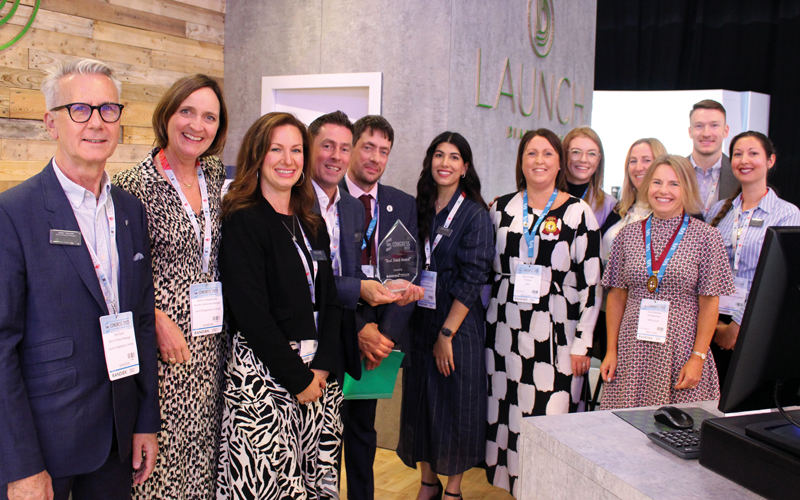
After a trip around all the exhibitor stands at this year’s Congress, IBMS President Debra Padgett, IBMS President Elect Joanna Andrew and IBMS Chief Executive David Wells presented two awards. We hear from the winners.
Best stand: Launch Diagnostics
Launch Diagnostics won the award for its sustainable stand made from recycled materials.
- What does your company do?
Launch Diagnostics is a supplier of laboratory-based diagnostic assays, instruments and technical service to health service pathology departments across many different disciplines.
- What is the idea behind your stand?
We wanted our stand to be as sustainable as possible. The concept was about how we could incorporate and recycle material into the build. The idea was to use as little new material as possible, or at least to use material with recycled content.
- What has been the response to your stand at Congress?
We had amazing feedback from customers, exhibitors and other stand builders.
- What does Congress mean to you?
Congress has always been one of the major events we attend. It’s a great opportunity to meet with long-standing customers, new customers and colleagues from other companies.
Best Shell Scheme Stand Award: Vivid Healthcare
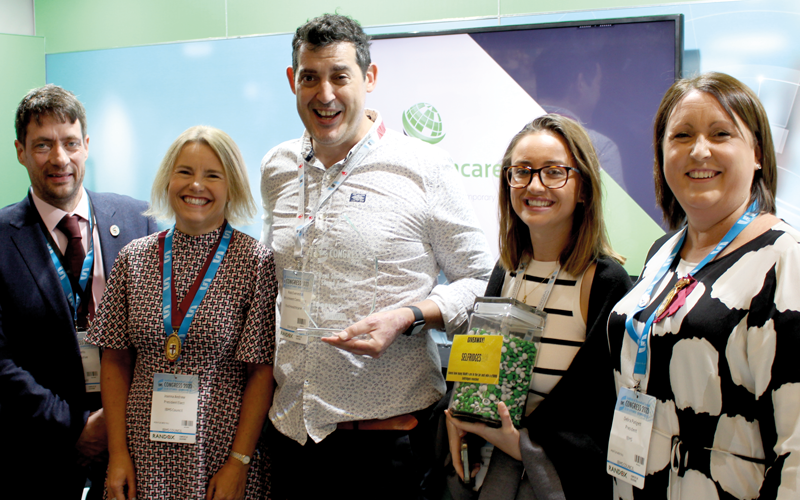
Vivid Healthcare won the award for their stand featuring “guess the number of M&Ms in the jar” with a £1000 Selfridges voucher as the prize.
- What does your company do?
We’re a company that supports healthcare organisations to maximise capacity and recruit great scientists to ultimately improve patient outcomes.
- What is the idea behind your stand?
We really just wanted to engage with as many people as possible, have a little fun and reach as much of our wonderful community as possible.
- What has been the response to your stand at Congress?
Honestly it was fabulous. Everyone was fantastic, super-engaged and I only wish everyone could have won the vouchers. But there was only one winner, who promised to split it with her partner in crime.
- What does Congress mean to you?
It’s a great opportunity to engage with colleagues and partners. It highlights what a great community we have and I feel privileged to be a small part of it.
Point-of-care testing: “We are the experts”
We do not need to carry out all point-of care tests (POCTs), but labs need to be involved early in the development of the tests, said IBMS Chief Executive David Wells.
David was delivering a session on Point of Care Testing: National Strategic Guidance for at Point of Need Testing, which was released earlier this year.
He said: “I have known for a long time that getting out into the community is a way to improve our diagnostics. We need to get our experts out there so people understand how we are working.
“We’ve got to make sure that we, as experts, work with people in different parts of the system to improve things for our patients.”
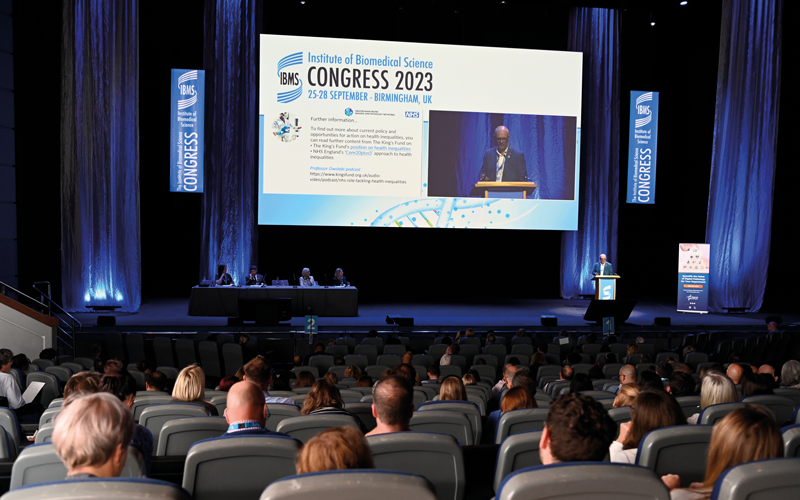
He added: “We should not necessarily be the ones doing all these tests, but we do have an obligation to patient safety and laboratories need to be involved at the early stages of development.”
The IBMS collaborated with the Royal College of Pathologists (RCPath) and the Association for Clinical Biochemistry and Laboratory Medicine (ACB) to produce the guidance.
It aims to communicate with those responsible for planning and commissioning novel patient services outside of traditional care settings. It outlines the strategic requirements to adopt POCT where it is needed and how to deliver safe and high-quality POCT within an accreditable framework.
To read the full guidance document, visit bit.ly/45mMueI
An amazing four days
The Closing Plenary was delivered by Professor Lucy Easthope of the University of Lincoln and was entitled “Disaster victim identification: A scientific, social and humanitarian responsibility”.
It was an engaging and moving talk that addressed disaster victim identity and looked at the vital importance of duty of care.
Introducing the final session, Debra Padgett, IBMS President, said: “I’m sure you will all agree, it has been an amazing four days. It’s been a pleasure for me to meet so many of you and I’m sure that some of the feedback will help us ensure that we make Congress 2025 even better and bigger than this one.”
The theme for this year’s event was “Linking learning to the laboratory” and it was the biggest IBMS Congress to date, with more than 20 key specialisms and areas of professional interest represented.
Speakers ranged from esteemed leaders in their fields, parliamentarians and chief scientists through to younger members of the profession driving their specialism forward with passion and innovation.
Alongside the talks there was a packed evening social programme for members to attend, which was perfect for networking and making new contacts.
There were also three days of poster presentations and the Congress Hall was packed with companies and organisations showcasing the latest cutting-edge advances and technologies.
Speaking to the Biomedical Scientist magazine as the event came to a close, Debra said: “Congress is always the highlight of the biomedical science calendar. It makes me so proud to see many smiling faces and people who are proud to be biomedical scientists.
“It is great having everybody back together again – it’s the thing that gives us our mojo back.
“This year was the best Congress ever and an amazing opportunity to hear what’s going on in the profession and look at the latest technological advances too.”
Image credit | IBMS-Congress | Photography-Ltd




